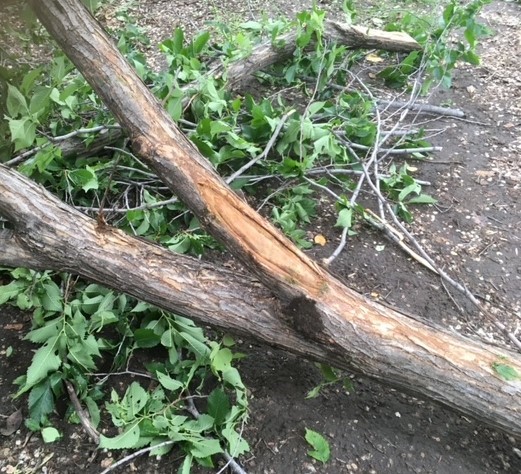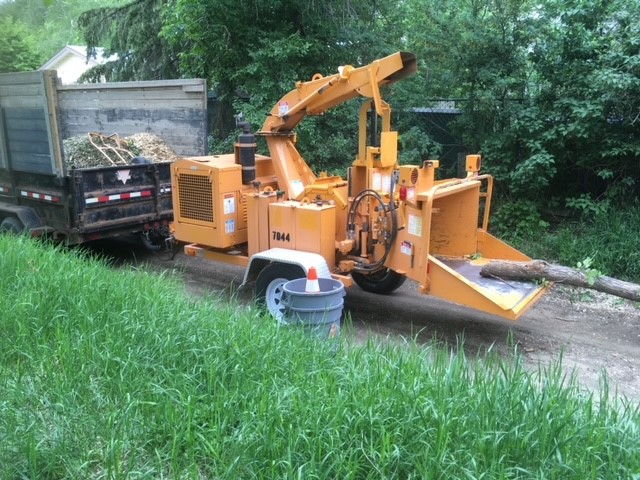Jill Thomson
Saskatchewan Perennial Society
Dutch Elm Disease (DED) has been with us for many years. It is thought to have originated in Southeast Asia, travelled to Europe in the late 1800s, and was first observed in North America in 1930. It was found in Quebec in 1944, and has since moved across Canada, being found in Manitoba and Saskatchewan in the 1970s and 80s. In Saskatchewan, the disease has travelled west along natural corridors of native elms that grow beside waterways such as Carrot River in the north and the Qu’Appelle valley in the south.
It is particularly important to keep the disease out of our urban areas because elms are invaluable shade trees that line our city streets – there are few trees that are as long-lived, sturdy and hardy. Some cities like Winnipeg have lost nearly all their elms and the city takes extreme measures to save the few that remain. Infected trees were identified in Saskatoon in 2015, 2020 and 2021. In Regina, it first appeared in 1981 and has popped up sporadically since.
The disease is caused by Ophiostoma ulmi, a fungus that clogs the water and nutrient transport tissues in the elm tree, killing branches and ultimately the whole tree. The fungus spreads from tree to tree by spores that cling to elm bark beetles. The spore-laden beetles bore into dead or dying elm wood to make cavities where they lay their eggs. Spores get dislodged inside the tree during this process, and fungal infection develops. The insect eggs hatch into larvae and feed inside the tree. They eventually emerge as mature beetles, which will likely be coated with fungal spores that can then be spread to other trees during egg-laying. This complex life cycle provides several points that allow us to reduce or prevent infection.
Many dollars have been spent to try and contain DED. The City of Saskatoon Parks Department has a crew dedicated to DED surveillance and testing during the season. The City also has programs for distributing educational materials, DED inspections, permits, specialized pruning schedules and monitoring. Additional budget resources are provided to promptly remove and dispose of infected trees when a positive infection is detected in the community. Infected trees in Saskatoon are removed immediately, chipped, and disposed of in the landfill. Neighbouring trees are monitored for up to 4 years to make sure that the disease hasn’t spread. There is also funding for educating the public on ways to recognize and deal with diseased trees.
Pruning elms at the correct time is critical to remove the dead or dying branches that are attractive egg-laying sites. The provincial elm pruning ban runs from April 1 to August 31; this coincides with the elm bark beetle’s egg-laying period. However, if infected trees are identified during spring and summer they are removed immediately, chipped and disposed of in the landfill site (not as compost waste).
Several years ago, in April, we noticed a broken elm branch above our garage, that was likely to fall and damage the roof. Also the same tree had branches overhanging and brushing against our neighbour’s roof, with the potential to damage the shingles. We contacted the city, and within 24 hours an inspector came to assess our tree. He wrote a permit which allowed us to prune specific branches, with instructions for the correct disposal of material (chipping on site and transfer to landfill in covered transport). This prompt response ensured the potential hazard was removed quickly, and no dying branches or cut wood offered an egg-laying site for the beetles.

Another way to minimize spread of the disease is to dispose of any dead elm wood correctly and not to use as fire wood. Storing and transporting elm wood is prohibited by provincial regulation at any time of the year.
In order to prevent DED from ruining our urban landscape it is important to follow these guidelines:
• Keep your elms healthy by pruning dying or dead branches during September 1 – March 31.
• Dispose of elm wood by chipping and taking to landfill.
• Do not store or move elm wood.
• If you see signs of DED (such as large, dead branches or individual branches with wilting and browning leaves that do not fall off in the summer), report them to your municipal authority.
Jill Thomson is a plant disease specialist (retired) who enjoys gardening with her family in Saskatoon.
This column is provided courtesy of the Saskatchewan Perennial Society (SPS; saskperennial@hotmail.com ). Check our website (www.saskperennial.ca) or Facebook page (www.facebook.com/saskperennial) for a list of upcoming gardening events.


